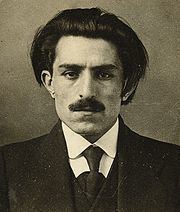Name Vahan Terian Nationality Armenian Role Poet | Period 1903-1911 Spouse Susanna Terian (m. 1911) | |
 | ||
Born Books Entrani, Coming to Terms: Selected Poems Education Saint Petersburg State University, Moscow State University | ||
Vahan Terian (Armenian: Վահան Տերյան; January 28, 1885 – January 7, 1920) was an Armenian poet, lyrist and public activist. He is known for his sorrowful, romantic poems, the most famous of which are still read and sung in their musical versions.
Contents
Biography
Terian was born in the Gandza village (განძანი) of Javakheti region of Georgia (then in Russian Empire). Schooled in Tiflis, he then studied at the Lazarian College in Moscow, where he was exposed to symbolism and joined the Russian Social Democrats. He was jailed by Czarist police for his political activity. He is mostly known for his poems dedicated to autumn and love. That's why Teryan is known as "Singer of Autumn" in Literature. He published his first book of poems, "Dreams at Dusk", in 1908, which made him an immediate sensation, Hovhannes Tumanian calling him the most original lyric poet of his age. He later published "Night Remembrance", "The Golden Legend", "The Return", "The Golden Link", "In the Land of Nairi" (where he substitute the word 'Nairi' for each instance where the word 'Armenia' would have suited), and "The Cat's Paradise". His poems are filled with images of rain, mist, pallid fields and shapeless shadows, symbols of sorrow, despair and eventually, peace.
In 1913, Terian left Moscow University for the University of St. Petersburg, where he majored in oriental languages, intensifying his political involvement. After the revolution he became representative of Armenians in the Ministry of Nations, personally working with Lenin and Stalin. He died in Orenburg of tuberculosis shortly before his 35th birthday. Each year there is a commemoration of his life in Javakhk region (Akhaltsikhe and Akhalkalak), at Gandza village, where he was born.
In 1916, Vahan Terian published a collection of poems entitled Land of Nairi (in Armenian: (Yerkir Nairi), in which he uses Nairi in place of Armenia. Likewise in 1923, Yeghishe Charents wrote a satirical novella entitled Land of Nairi, using once again Nairi as a synonym for Armenia. Hayastan Yeghiazarian, interestingly, used Nairi Zarian as his pen-name, replacing his first name, Hayastan (which is what Armenians call Armenia in their own language since the Late Middle Ages) with Nairi.
Vahan Teryan is buried at Komitas Pantheon which is located in the city center of Yerevan.
